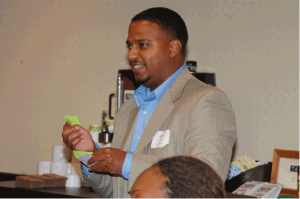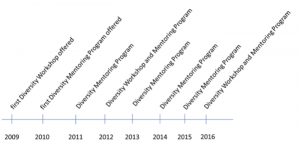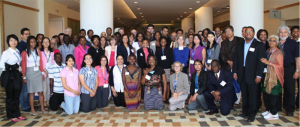JSM Diversity Workshop and Mentoring Program: Reflections After 7 Years
Brian A. Millen
Since 2009, the ASA Committee on Minorities in Statistics (CMS) has offered one of two concomitant programs at JSM. These programs are often spoken of interchangeably, as the core objectives of fostering enduring mentoring relationships and preparing statisticians of diverse backgrounds for career success are a common thread. Here, I share the history of these programs, provide a look at the 2016 program, and offer a vision for the future growth and implementation of the programs.
History
The first JSM Diversity Workshop (then known as the Pre-JSM Diversity Workshop), initiated by Brian Millen, was held in 2009 in Washington, DC. The program was funded through an ASA Member Initiative grant, with additional funding support provided by SAS, the Bureau of Labor Statistics, Procter & Gamble, and Eli Lilly and Company.
Seeking to establish a community of minority statisticians who could support one another’s development and success, a small group of committed volunteers developed the single-day program that focused on skills development and awareness for statisticians across varying career levels (i.e., undergraduate and graduate students and career professionals). Sessions included presentations and panels on career success, graduate school success, networking while at JSM (and in general), successful grant applications (by an NSF grant officer), and successful career searching and interviewing. There also was a ‘speed’ mentoring session in small groups. Several well-known leaders in statistics—including Bob Rodriguez, Sastry Pantula, Tommy Wright, Lloyd Edwards, and Alicia Carriquiry—participated. It was also an early example of a productive partnership with AAAS, which facilitated a valuable session on networking during the workshop. (A few years later, the ASA would announce a broad partnership between the two organizations.)
Feedback from the initial workshop was overwhelmingly positive. It was clear, based on response from participants—including ASA leaders—that this was a program that must continue. Additionally, feedback indicated a few clear changes. First, the program would move from Saturday at JSM to Sunday. This would enhance the visibility of the program as an integral component of JSM and make participation easier. Second, the program would expand its mentoring component. This is something participants indicated they wanted more of. Last, the organizers agreed the large workshop would ideally be offered every two to three years at JSM. This left an opportunity for the alternate non-workshop years.
The following year, in 2010, a minority-focused mentoring program was offered. Known as the Cavell Brownie Scholars program, it focused on minority PhD candidates who were considering academic careers upon graduation and matched them with top-notch, dedicated faculty members who would help them prepare for this career transition. The brain child of Marcia Gumpertz, the program was supported through an ASA Member Initiative grant.
In addition to 1-1 mentoring, the program included small group sessions/discussions about relevant topics, such as contributions of mathematicians and statisticians of color and stereotype threat and imposter syndrome. This initial program, like the 2009 workshop, was a huge success. The opportunity for growth of these two programs was clear. Much of the blueprint to actualize growth of the mentoring component to the JSM Diversity Workshop was created from the 2010 Cavell Brownie Scholars program.
Expanding the scope of constituencies to address the mentoring needs of all early- to mid-career statisticians from diverse backgrounds became the key to successfully merging the two into what would later become known as the JSM Diversity Workshop and Mentoring Program (DWMP), or the JSM Diversity Mentoring Program (DMP).
The path forward was clear. The DWMP would be offered ativan online uk approximately every three years. It would include a full-day workshop that targeted approximately 100 participants along with 1-1 mentoring and small-group sessions throughout the week of JSM for those accepted into the mentoring component. The JSM DMP would be offered in all non-workshop years. This program would be smaller, but include all the 1-1 mentoring and small-group sessions. Soon, the ASA would include support for the program in its annual budget.
Today
The 2016 DWMP took place at JSM in Chicago. Applicants exceeded 100 by the priority registration deadline. Twenty-six candidates were accepted for the mentoring component—the largest number to date. Invited speakers included DuBois Bowman, Aarti Shah, Sastry Pantula, Ric Weibl, Bob Bell, and Sally Morton.
Additionally, several ASA sections offered sponsorship support: Statistics in Epidemiology, Statistics in Government, Statistics and the Environment, Mental Health Statistics, and Statistics in Imaging. Overall, funding for this year’s DWMP grew approximately 25–30% above other offerings, increasing our ability to support students. Participants represented diverse backgrounds. Mentors and planning committee members were leaders in the field and included several who were previous participants. In whole, there was a great degree of excitement and anticipation for the program.
Future
As I look to the future, I see opportunities to expand on key strengths of the program’s implementation thus far:
Community
Over the years, I’ve seen strong, enduring relationships form and grow. Word of mouth is a primary reason for individuals who now apply to the programs. Beyond that, we receive repeat applications year after year. Some of this is from past participants and is a testimony to the positive previous experience. (Unfortunately, some of this is due to limits on capacity in any given year.) The 2019 DWMP will mark an opportunity to reflect on the previous 10 years. I envision a grand program, complemented by a reunion of previous participants who affirmatively commit to contributing to its future growth and success!
Collaboration
Over the years, we’ve built long-standing relationships with a handful of partners who contribute immensely to the success of the programs. These partners share in the successful outcomes of this important work. New partners joined for the 2016 DWMP. In the next five years, I envision the list of partners doubling. With this, I see increased investment and enhanced quality of outcomes, with fewer applicants being turned away due to capacity.
Commitment
What is unique about the CMS is its extended leadership. While many on committees cease involvement when their terms end, the CMS has created a culture that values the legacy and building of past leaders and maintains their involvement. In this way, history and learning are not lost and enduring professional relationships and collaborative partnerships thrive. Emphasis is on growth and improvement, rather than reinventing the wheel. Currently, past chairs work alongside current chairs in a supportive fashion. In the future, I see this continuing, with multiple committee members—past and current—increasing the success of the programs.
At the heart of the DWMP and DMP—and any mentoring or development initiative—is people. I’m pleased to have served our profession through these programs. My life, personally and professionally, has been enriched by the privilege of serving. A heartfelt thanks to all those I’ve met on this journey!
Applications are due in early July. Check the Committee on Minority Statistics webpage for details.




















